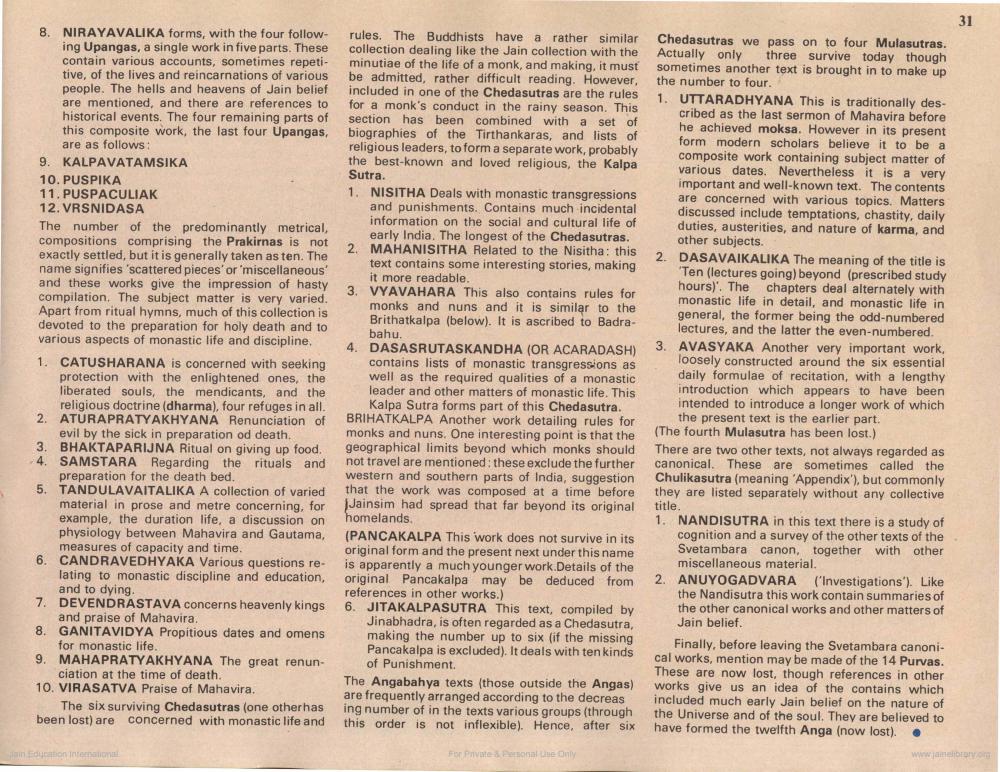________________
8. NIRAYAVALIKA forms, with the four follow
ing Upangas, a single work in five parts. These contain various accounts, sometimes repetitive, of the lives and reincarnations of various people. The hells and heavens of Jain belief are mentioned, and there are references to historical events. The four remaining parts of this composite work, the last four Upangas,
are as follows: 9. KALPAVATAMSIKA 10. PUSPIKA 11. PUSPACULIAK 12. VRSNIDASA The number of the predominantly metrical, compositions comprising the Prakirnas is not exactly settled, but it is generally taken as ten. The name signifies 'scattered pieces' or 'miscellaneous and these works give the impression of hasty compilation. The subject matter is very varied. Apart from ritual hymns, much of this collection is devoted to the preparation for holy death and to various aspects of monastic life and discipline. 1. CATUSHARANA is concerned with seeking
protection with the enlightened ones, the liberated souls, the mendicants, and the
religious doctrine (dharma), four refuges in all. 2. ATURAPRATYAKHYANA Renunciation of
evil by the sick in preparation od death. 3. BHAKTAPARIJNA Ritual on giving up food.
SAMSTARA Regarding the rituals and preparation for the death bed. TANDULAVAITALIKA A collection of varied material in prose and metre concerning, for example, the duration life, a discussion on physiology between Mahavira and Gautama,
measures of capacity and time. 6. CANDRAVEDHYAKA Various questions re
lating to monastic discipline and education,
and to dying. 7. DEVENDRASTAVA concerns heavenly kings
and praise of Mahavira, 8. GANITAVIDYA Propitious dates and omens
for monastic life. 9. MAHAPRATYAKHYANA The great renun
ciation at the time of death. 10. VIRASATVA Praise of Mahavira.
The six surviving Chedasutras (one other has been lost) are concerned with monastic life and
rules. The Buddhists have a rather similar collection dealing like the Jain collection with the collection de minutiae of the life of a monk, and making, it must be admitted, rather difficult reading. However, included in one of the Chedasutras are the rules for a monk's conduct in the rainy season. This section has been combined with a set of biographies of the Tirthankaras, and lists of religious leaders, to form a separate work, probably the best-known and loved religious, the Kalpa Sutra 1. NISITHA Deals with monastic transgressions
and punishments. Contains much incidental information on the social and cultural life of
early India. The longest of the Chedasutras. 2 MAHANISITHA Related to the Nisitha: this
text contains some interesting stories, making
it more readable. 3. VYAVAHARA This also contains rules for
monks and nuns and it is similar to the Brithatkalpa (below). It is ascribed to Badrabahu. DASASRUTASKANDHA (OR ACARADASH) contains lists of monastic transgressions as well as the required qualities of a monastic leader and other matters of monastic life. This
Kalpa Sutra forms part of this Chedasutra. BRIHATKALPA Another work detailing rules for monks and nuns. One interesting point is that the geographical limits beyond which monks should not travel are mentioned: these exclude the further western and southern parts of India, suggestion that the work was composed at a time before
Jainsim had spread that far beyond its original homelands (PANCAKALPA This work does not survive in its original form and the present next under this name is apparently a much younger work.Details of the original Pancakalpa may be deduced from references in other works.) 6. JITAKALPASUTRA This text, compiled by
Jinabhadra, is often regarded as a Chedasutra, making the number up to six (if the missing Pancakalpa is excluded). It deals with ten kinds
of Punishment The Angabahya texts (those outside the Angas) are frequently arranged according to the decreas ing number of in the texts various groups (through this order is not inflexible). Hence, after six
Chedasutras we pass on to four Mulasutras. Actually only three survive today though sometimes another text is brought in to make up the number to four. 1. UTTARADHYANA This is traditionally des
cribed as the last sermon of Mahavira before he achieved moksa. However in its present form modern scholars believe it to be a composite work containing subject matter of various dates. Nevertheless it is a very important and well-known text. The contents are concerned with various topics. Matters discussed include temptations, chastity, daily duties, austerities, and nature of karma, and
other subjects. 2 DASAVAIKALIKA The meaning of the title is
'Ten (lectures going) beyond (prescribed study hours). The chapters deal alternately with monastic life in detail, and monastic life in general, the former being the odd-numbered
lectures, and the latter the even-numbered. 3. AVASYAKA Another very important work,
loosely constructed around the six essential daily formulae of recitation, with a lengthy introduction which appears to have been intended to introduce a longer work of which
the present text is the earlier part. (The fourth Mulasutra has been lost.) There are two other texts, not always regarded as canonical. These are sometimes called the Chulikasutra (meaning 'Appendix'), but commonly they are listed separately without any collective title. 1. NANDISUTRA in this text there is a study of
cognition and a survey of the other texts of the Svetambara canon, together with other
miscellaneous material. 2. ANUYOGADVARA ('Investigations'). Like
the Nandisutra this work contain summaries of the other canonical works and other matters of Jain belief
Finally, before leaving the Svetambara canonical works, mention may be made of the 14 Purvas. These are now lost, though references in other works give us an idea of the contains which included much early Jain belief on the nature of the Universe and of the soul. They are believed to have formed the twelfth Anga (now lost).
www
P
onale Only




